Deliberating on the existing and alternate realities of a site of collective memory.
What happened in the Pragati Maidan complex in recent years has undergone a lot of deliberation. While the predicament of the Hall of Nations deserves disgruntlement and public outrage, which is already the case, it is now necessary to view reality as is. What is the present reality of the IECC complex that was conjured on a clean slate with an overnight demolition? What do the new buildings speak of and what values do they convey? The grand G20 summit that was hosted recently in the complex has further brought the campus under the global spotlight. This makes it all the more pertinent to shed light on the new complex as it exists now, with the benchmark of what existed before, so that one may dovetail from there into imagining alternate realities of Pragati Maidan.
One may ask, why is it even relevant to speak about an imagination removed from reality, but it is essential since it shows the world how things could have been any different. It is essential to provoke reflections and stir emotions- be it of regret or of ridicule- to allow for discourses to be formed that in turn catalyse positive change.
This article will attempt to build a horizon between 2 dimensions- the existing mirrored with the illusionary alternate, of the Pragati Maidan complex.
Locating the site on a Historical Palimpsest
New Delhi is a city with multiple historic layers that include the Mughal cities of Shajahanabad, Mehrauli, Nizamuddin, and a colonial layer of Lutyens’ and Baker’s Delhi. When one attempts to plot the Pragati Maidan complex in this rich context, it can be perceived as being a part of the layer of post-independent India’s builtscape. A symbol of a democratic country’s search for modernity in the “Indianness”, making it a valuable asset and an inextricable link in the historic timeline of the city. With this perspective, it goes without saying that the retention of the Hall of Nations on this site would have been a crucial step in preserving a vital linkage in the collective memory of the city. Nonetheless, conducting a comparative overview between the old and new complexes is essential to clarify how each of the buildings contributed/contributes to the larger historic landscape. The tangible lens, to begin with, would be the Architectural character of both complexes.
Architectural Character- The Question of Aesthetics
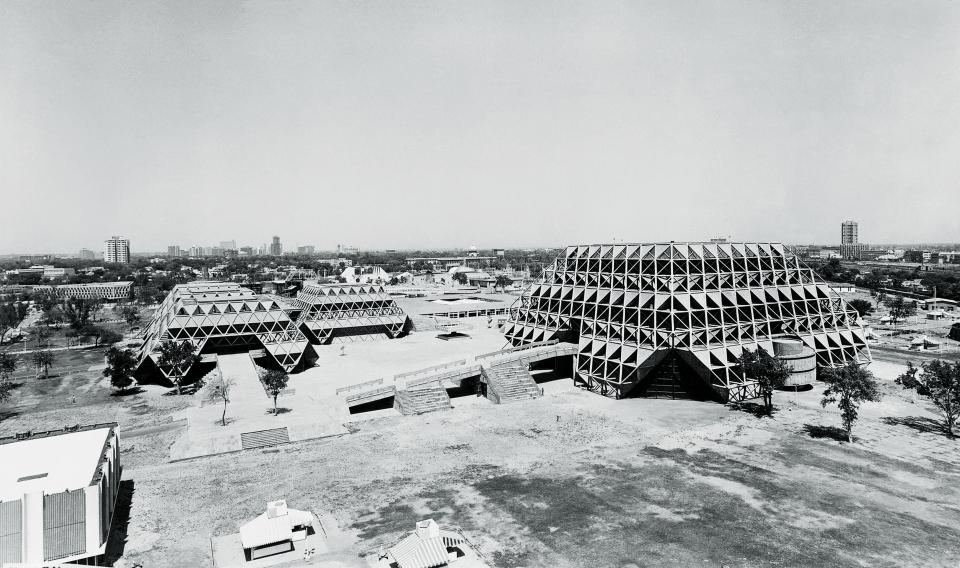
The Architectural expression of the Hall of Nations (HoN) envisioned by Rewal and Raj combined not just a symbolic showcase of technological prowess in a country aspiring to modernity, but also presented an example of creating complex geometrical forms using hands-on, pragmatic processes of production. In a semi-industrialised country where cast-in-situ concrete remained the cheaper and hence the more viable option, the pavilion demonstrated possibilities of achieving large spans and clean design aesthetics, employing resourceful processes of “jugaad” or “frugal engineering”1.
For that time, the vision for the HoN was a pioneering one, and strongly contextualized within a post-independent socio-cultural, technological and economic milieu.
The Hall of Nations structure had a 73x73m base with a 30m height, and the Hall of Industries comprising 4 smaller exhibition halls each had a 40 x40 m base with a height of 18m. The building footprints altogether add up to 12000 Sqm of built-up area encompassing seamless circulation paths connecting one structure to the other. Truncated pyramids formed by pyramidal spaceframes naturally resulted in a coherent shading device, making it climate-responsive. The complex also integrated the Nehru Pavilion, a permanent exhibition on the life of India’s first Prime Minister Jawahar Lal Nehru, that was embedded below the level of the complex and accessed via a large staircase.

If one had to comment on the aesthetics of the new complex, the renders designed by Aedas and executed by ARCOP look like a shiny vision for a “world-class” convention centre of global appeal. The campus now consists of a series of rectilinear and circular buildings arranged on a 125-acre site with manicured lawns containing walkways and open-air amphitheatres. The building that has received the most media attention in the complex is the Bharat Mandapam which spans almost 200 m in one direction and approximately 130 m in the other, forming an oval with an overall footprint of 26000 sqm, more than double the footprint of HoN complex.
The facade, clad with bands of red Jaipur sandstone and ribbons of slant glazing running along its periphery, appears altogether flat, lacking depth, and ends up looking like one of the many run-of-the-mill aluminium-clad commercial complexes that Indian cities have been witnessing since the early 2000s.
The other buildings in the complex also fail to impress in that they steer clear from taking a route exploring aesthetic grammar stemming from the complexities of the site. The project report of the IECC uploaded on the Indian Trade Promotion Organisation’s (ITPO) website claims that the architecture derives its form from the historic Lutyens city, while the architects contend that it was a translation of a shankha or the conch, blown during Hindu rituals. These claims appear as forced substantiations to a master plan that was planted on a site swept clean of past links.
Interiors- Semiotics and Politics of Indianness

The interior aesthetics of the HoN was a natural derivation from the architectural form. One that crafted a play of geometrical forms that created alternating modules of opacity and transparency. This seamless integration of the exterior and interior brought forth an uncontrived experience of the building spaces.
The Indianness in the structure was born out of the “peculiarities of place”, in Frampton’s words- a critical regionalist approach that developed a rational outcome rooted in the context of resource availability and technology, without the need for resorting to the politics of symbolic aestheticization.

Image source: The Week; Photo by Sanjay Ahlawat
In the Bharat Mandapam building, the interiors are clearly planned as a separate layer wherein the spatial experience of the interiors remains largely unaffected by the design of the external facade. The functions of the building are nevertheless state-of-the-art, hosting a huge amphitheatre, meeting rooms, multipurpose halls, et al. provided with the latest technological aids, designed to host global conferences and summits. But what is striking is the obvious emphasis on ancient Indian concepts pasted to the interior. Be it a wall dedicated to Yoga asanas, a relief mural portraying “Surya-Shakti”, or carpets carrying Peacock feather motifs.
One can quite evidently note that interior design acts primarily as a semiotic device that clearly attempts to embody a certain idea of “Indianness”.
As Fahad Zuberi writes in his op-ed for Indian Express, “The building takes a recourse of pasting meaning on top of itself- Like a sticker printed with a brick pattern pasted on an aluminium panel.” Needless to say it is noteworthy that the interior finishes were produced painstakingly by artisans who also received patronage through the project, but the production of the building could have gone beyond using these elements as mere decoration, to building an architecture that wove craftsmanship to its core. Just like Krushi Bhavan does, in Orissa.
The Value of Modern Heritage in India
Modern Heritage is an integral aspect of the heritage discourse globally, and yet it is not valued enough to warrant preservation in India.
The world over, there are organizations like DOCOMOMO2 (Documentation and Conservation of buildings, sites, and neighbourhoods of the Modern Movement) that stand for the principle that modern heritage merits as much a need for preservation as earlier periods do. Despite petitions by national and international cultural institutions like INTACH (Indian National Trust for Art and Cultural Heritage), MoMA (Museum of Modern Art, New York), and various
other collectives, the HCC (Heritage Conservation Committee) did not budge from its stand that only buildings older than 60 years can be listed as Heritage. Overnight the Hall of Nations structures were razed down by ITPO even though the petition by INTACH was still being heard at court.
Processes of development today are taking purely capitalist routes, concerned only with the fiscal value of land parcels, and this pattern can be irrevocably damaging to socio-cultural and ecological environments.
Historian William J.W Curtis refers to this very rapacious pattern of development when he laments about the future of heritage in India and appeals for its urgent attention, “It is the business of a secular Republic to look after and maintain major and sometimes minor examples of all periods and all religious denominations”3.
There is a pressing need to educate the larger public about the importance of Modernist heritage in India, a genre that was associated with the birth of a democratic nation moving towards an independent way of thinking.
Need for a sensitive way forward- learning from global approaches.
The Heritage discourse has evolved in leaps and bounds over the years to become more accommodative. The conversation now includes more styles and scales, and a wider scope that spreads to precincts and even cities. It also moves into a more nuanced understanding of “heritage”. For instance, Historic landscape Characterisation (HLC) is a tool used to assess heritage sites in the UK, that views heritage as an act of place-making involving the local community4 through participatory processes. This approach identifies places not just for their cultural and historical values but also for the value they hold in collective memory. Professor of Heritage Studies, Rodney Harrison refers to these places as “unofficial” heritage, as opposed to official heritage which is those that are listed by the Government and Heritage Agencies as properties of outstanding value5.
In his essay “The Conservation Plan”, James Semple Kerr says, “Heritage can be commemorated in ways other than being retained. It can be modified, reused, kept as abstract traces or markers rather than as a whole”6.
Globally, especially in European countries, there is a strong culture of historic preservation and innovation in approaches to conservation. For example, Zaha Hadid’s extension of the Middle East Centre on the Oxford University campus (also deemed as a UNESCO heritage site) in the UK is an example of sensitive development within a historical context7. The stainless steel tunnel housing a library and archives has a facade that reflects the surrounding landscape. The structure curves around the existing Sequoia tree so as to not harm it, and matches the scale of the surrounding buildings without becoming
overwhelming.
Another example of old meets new, is the expansion of the National Museum of Zurich, by Christ & Gantenbein. The U-shaped Neo-Renaissance plan of Master architect Gustav Gull, built in the 1800s is closed off with a concrete contemporary extension to form a loop with an open-to-sky courtyard, allowing for free-flowing circulation within the structure8. These are just a few illustrations from a large repository of global examples of sensitive approaches to building with heritage.
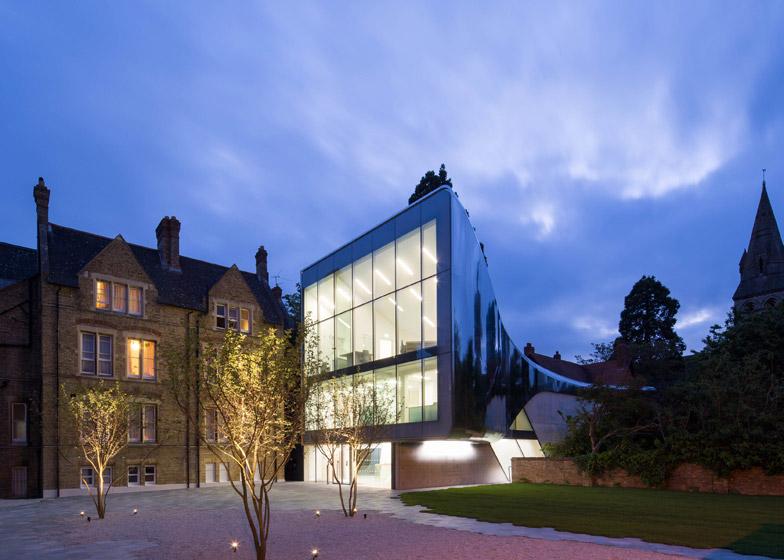
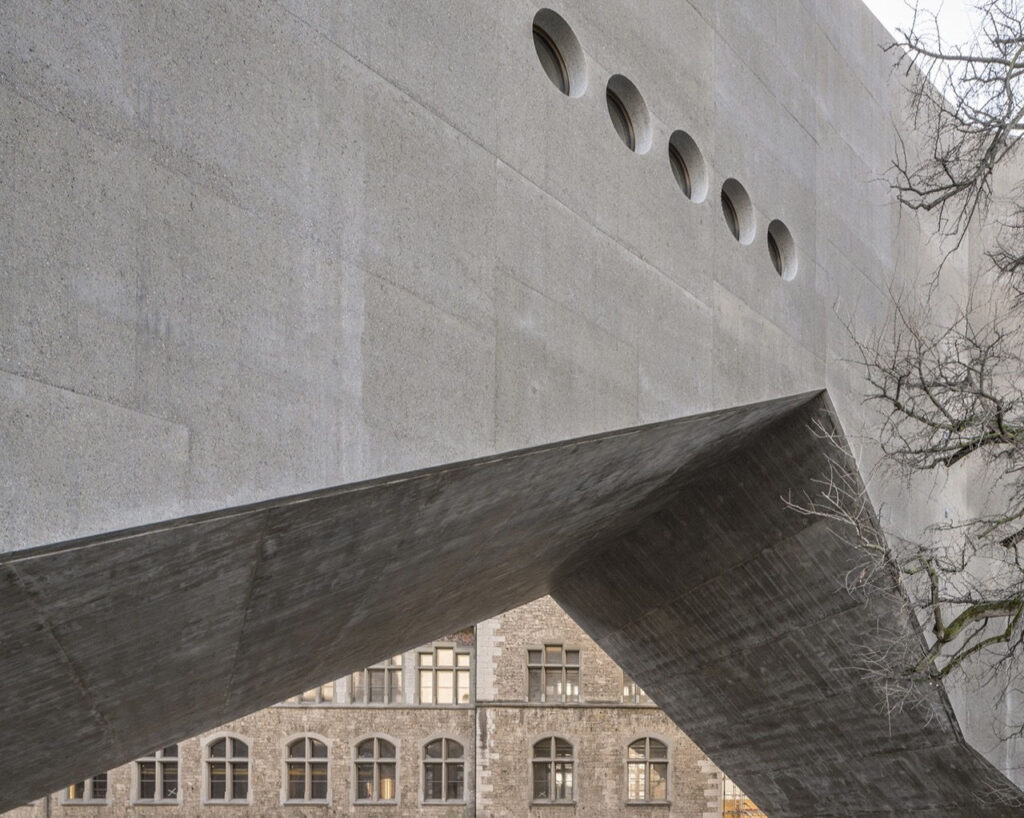
An Unwarranted Demolition – Concerns of Sustainability
The new complex makes feeble claims of minimising emissions by obtaining a Griha rating9 for the convention centre building and exhibition halls. Whether it makes use of alternate means of harnessing energy is not specified considering it incorporates a large percentage of air-conditioned spaces. In fact, the razing down of the older structures on the site itself goes against the tenets of sustainable processes of development, with huge resource losses and the production of non-biodegradable waste that otherwise could have been avoided with the adaptive reuse of the structures.
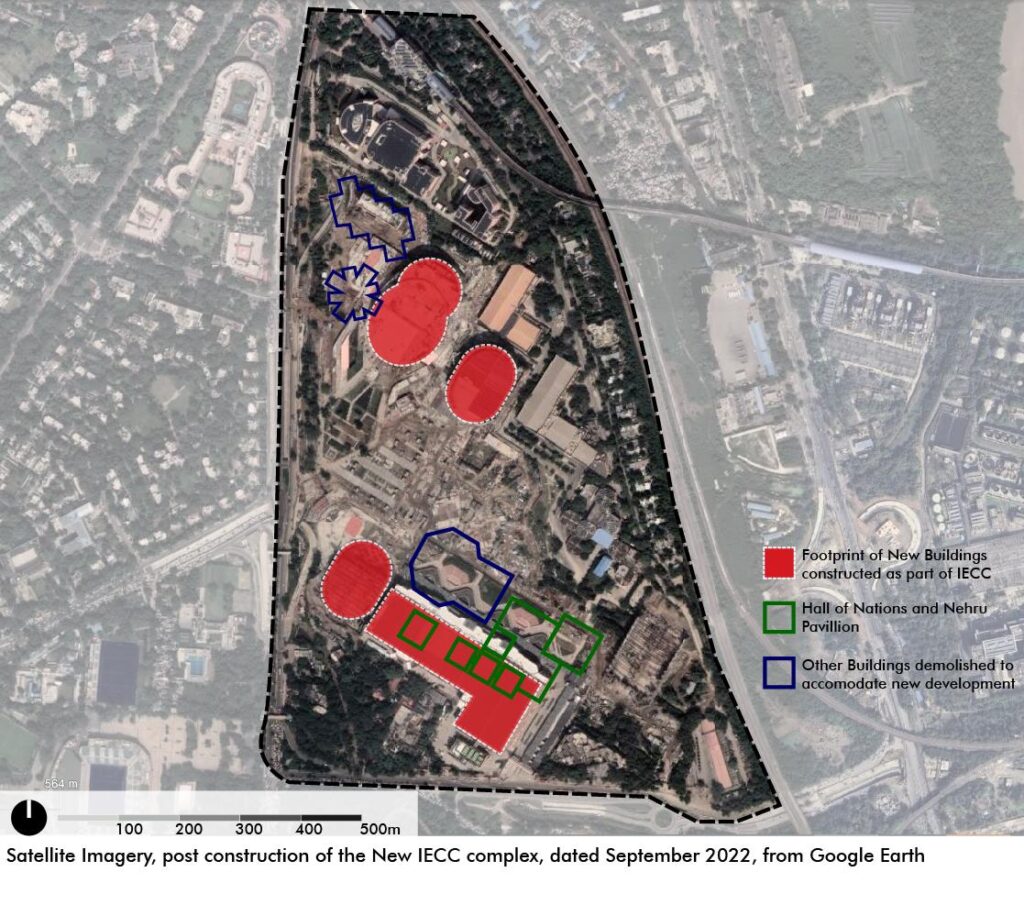
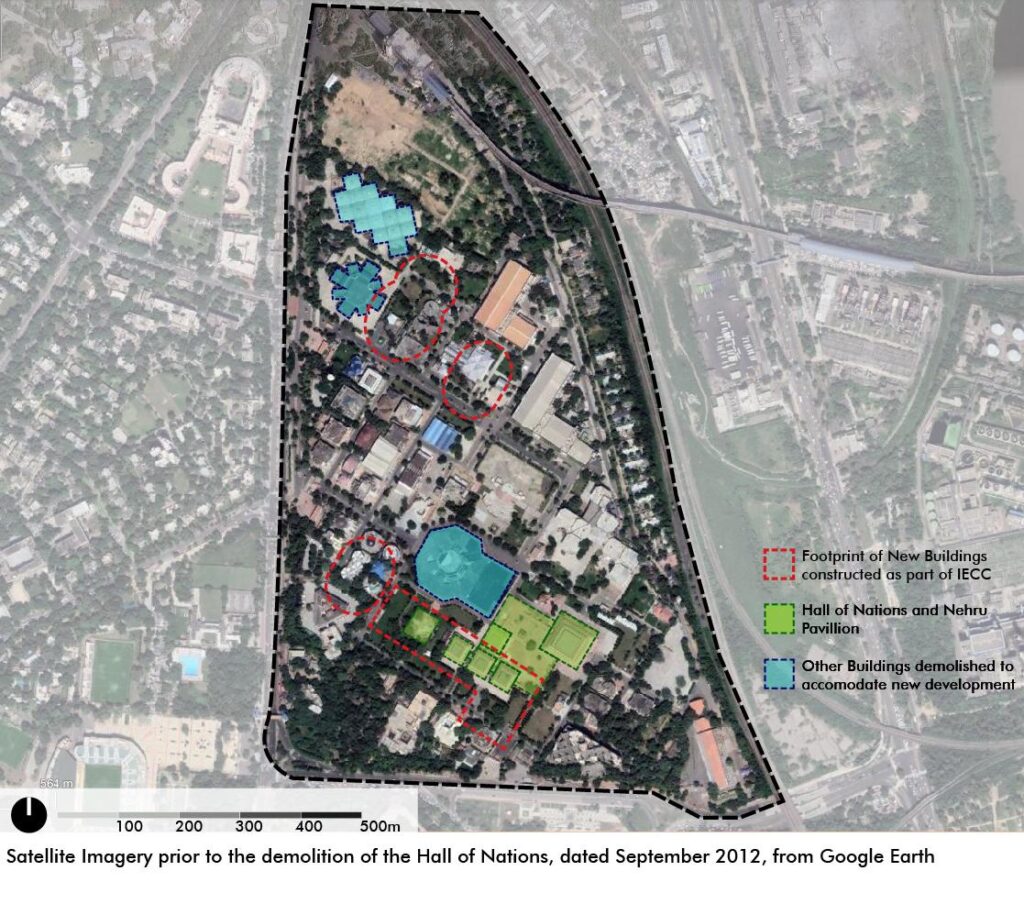
The HoN was conceived as a gestalten vision wherein each pyramidal module even if complete in itself together contributed to assembling a whole that was greater than the sum of its parts. A vision triggered by Buckminster Fuller’s Geodesic Dome, built in 1967, 10 years prior to the HoN, also built as a pavilion in an expo. Ironically, Bucky’s Dome still stands proudly, as an ode to a pioneering vision of technological innovation in modern heritage.
Despite being subjected to catastrophes like a massive fire in 1976, the dome has undergone several renewal cycles, the most recent one done in 2017, by transdisciplinary design firm, Lemay, as a part of a city-wide celebration of Montreal’s 375th anniversary10. The design of the renewal aimed to recreate the “unifying and festive spirit” of the Expo of ‘67 which was a landmark in Canadian history for its social, cultural and technological advancements. These instances of the Montreal dome bear an uncanny resemblance to the context around HoN (also built as pavilions for International Trade Fair Expo- Asia ‘72). Yet, the trajectory taken by the Indian government in terms of the future of the complex was the polar opposite of “celebration”.
The IECC complex could have taken a very different route that was more sensitive to the historical layers in and around the site. A conservation plan had been making the rounds of the internet at the time of demolition, that pointed out how the Hall of Nations could still have been preserved as an integral part of the new complex.
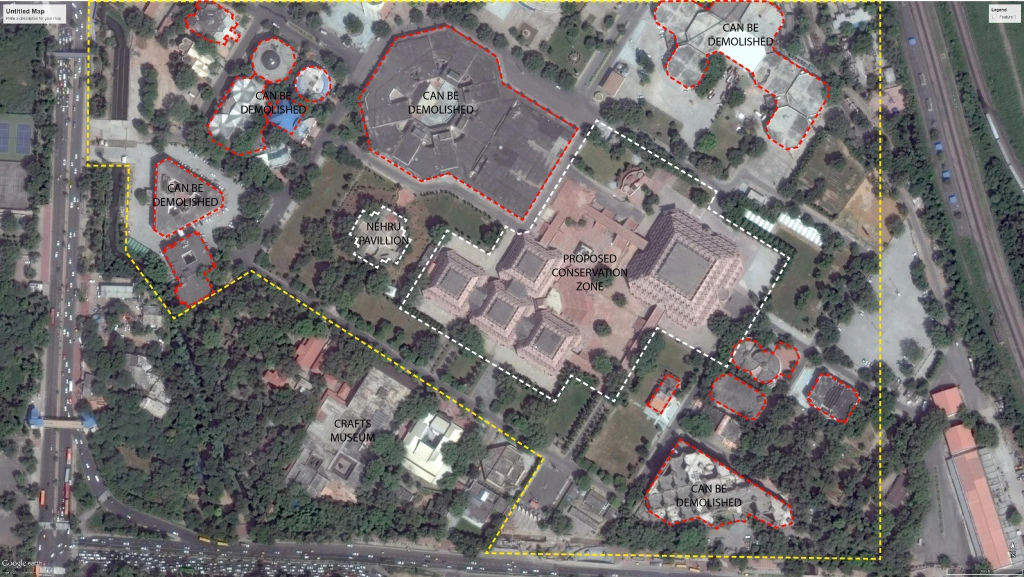
Alternate Realities of Pragati Maidan- What could have been.
The new complex could have retained the Hall of Nations entirely or in parts, integrating it with the landscape and adapting it to alternate programs. However, for whatever reasons, be it political apathy or sheer ignorance, the complex was flattened. What would’ve been the case if the old complex had been retained and the design did in fact take cues from the context of the historic city? We asked AI to imagine this alternate scenario and were pleasantly surprised with the results. Following are some conceptual representations of the alternative realities of the Pragati Maidan complex. An alternate dimension that preserved historic links, respected collective memory and was sensitive to the environment.

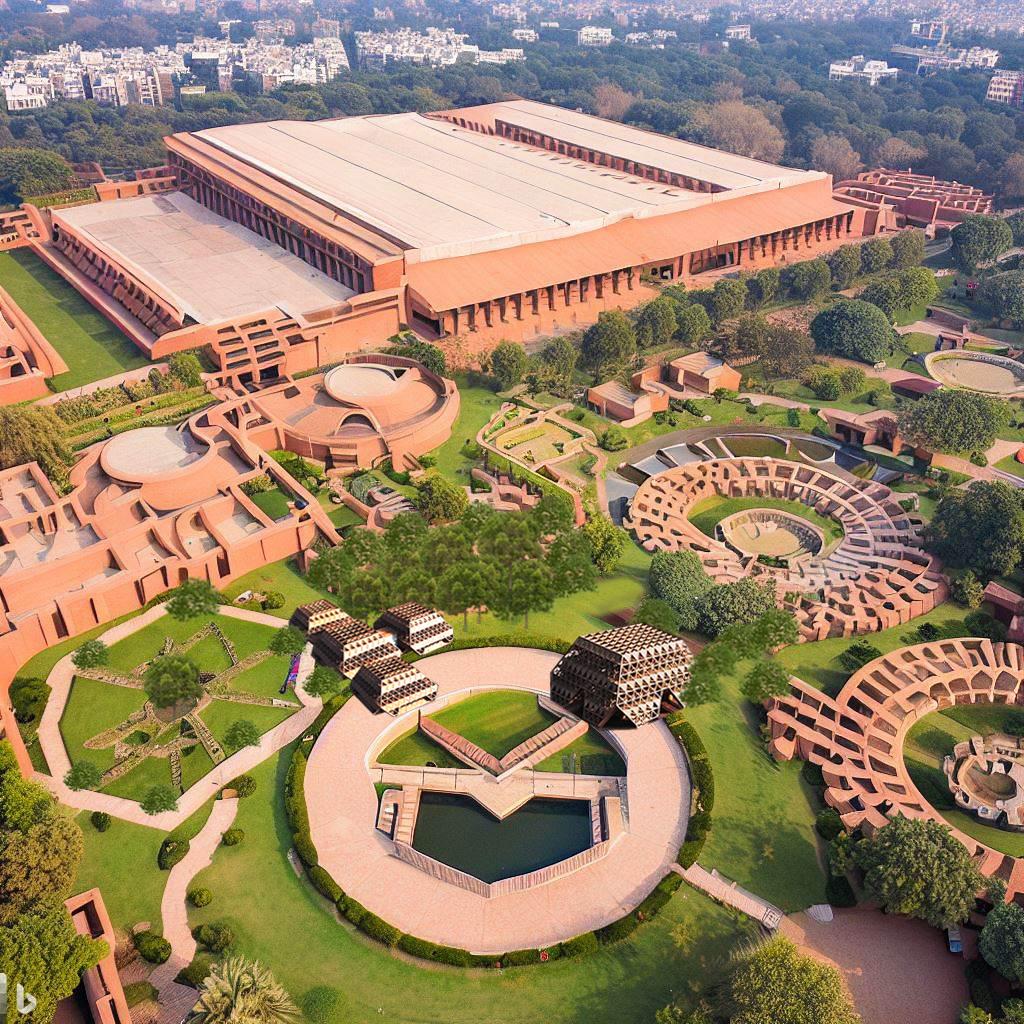

- Scriver, P., & Srivastava, A. (2015). India: Modern Architectures in History. Reaktion Books.
- DOCOMOMO, (Documentation and Conservation of buildings, sites, and neighbourhoods of the Modern Movement) www.docomomo-dc.org
- Protecting Modern Masterpieces in India – A Conversation between William J.R. Curtis and an Unknown Indian, Think Matter, www.thinkmatter.in
- HLC definition and intent, www.historicengland.org.uk
- “What is Heritage”, Essay by Rodney Harrison- https://www.academia.edu/776638/What_is_Heritage
- “The Conservation Plan”, by James Semple Kerr, Essay from Heritage Reader, by Graham Fairclough, Rodney Harrison, John H Jameson Jnr and John Schofield, 2016, Routledge publications.
- Zaha Hadid adds a shimmery steel tunnel to an Oxford University college, written by Amy Frearson, 28 May 2015 ,www.dezeen.com
- Swiss National Museum / Christ & Gantenbein, published on February 1, 2016, https://www.archdaily.com/781176/swiss-national-museum-christ-and-gantenbein
- Data obtained from ITPO project presentation on website- https://indiatradefair.com/
- Montreal’s Expo ‘67 site receives massive renovation by Lemay: https://www.archpaper.com/2019/10/former-expo-67-site-massive-renovation-lemay/
References
Bhatia, G. (2018, July 21). What will the new Pragati Maidan add to Delhi’s skyline? The Hindu.
https://www.thehindu.com/society/what-will-the-new-pragati-maidan-add-to-delhis-skyline/arti
cle24474415.ece/amp/
Cutieru, A. (2021, November 10). Aedas Reveals Design of Exhibition and Convention Centre in
New Delhi. ArchDaily.
https://www.archdaily.com/971658/aedas-reveals-design-of-exhibition-and-convention-centre-i
n-new-delhi
Dasgupta, R. (2023, August 2). Why Bharat Mandapam is better than the pyramids. Firstpost.
https://www.firstpost.com/opinion/why-bharat-mandapam-is-better-than-the-pyramids-129475
42.html
Rewal, R., Raj, M., & Correa, C. (n.d.). Hall of Nations and Nehru Pavilion | Aζ South Asia.
Architexturez South Asia.https://architexturez.net/doc/az-cf-123722
Stierli, M., Singh, K., Lee, K. S., & Tolentino, J. (2017, August 29). Remembering the Hall of
Nations, New Delhi – post. https://post.moma.org/remembering-the-hall-of-nations-new-delhi/
Varghese, S. (2023, July 30). New Pragati Maidan complex: What we lose in the pursuit of
superlatives.
https://indianexpress.com/article/opinion/columns/new-pragati-maidan-complex-what-we-losein-
the-pursuit-of-superlatives-8867826/



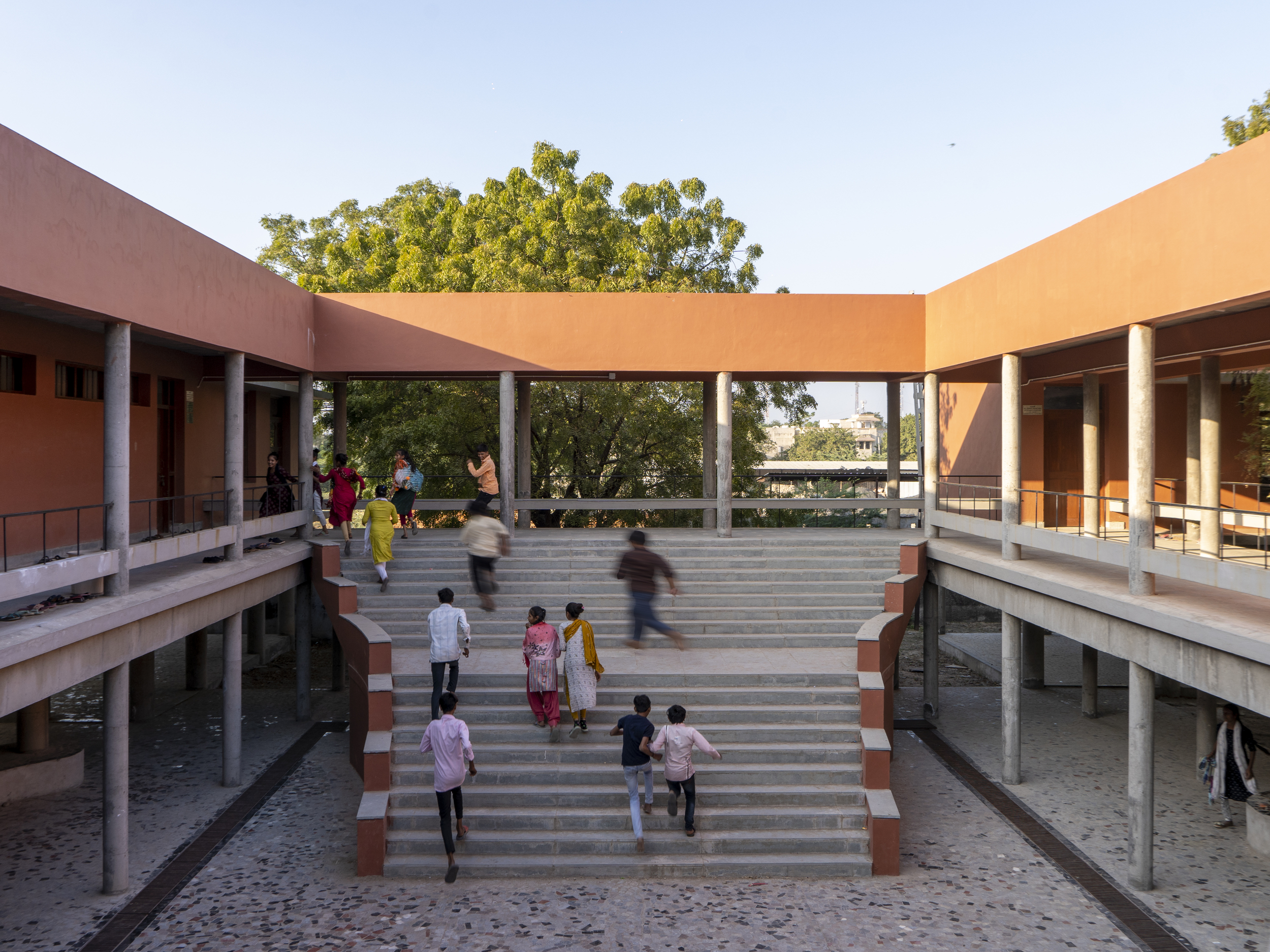
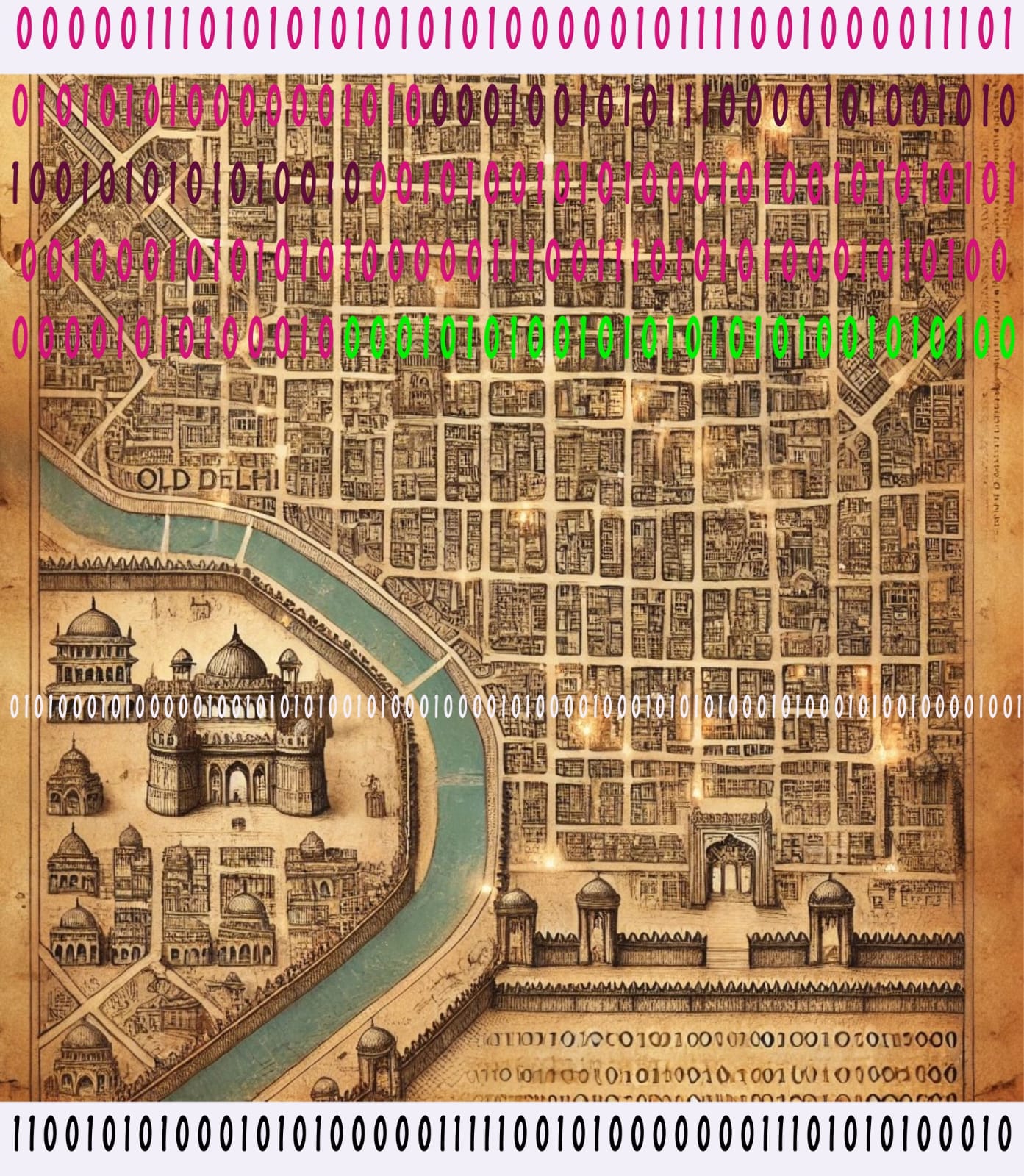

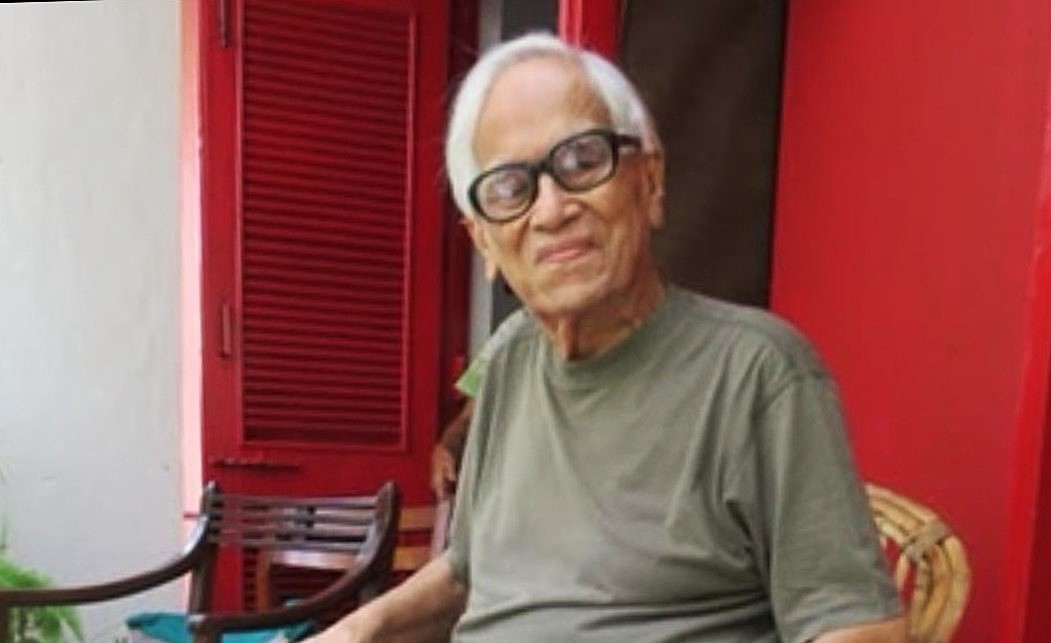
One Response
Nicely written. Authors appreciated for their imagination of the alternative realities of Pragati maidan.